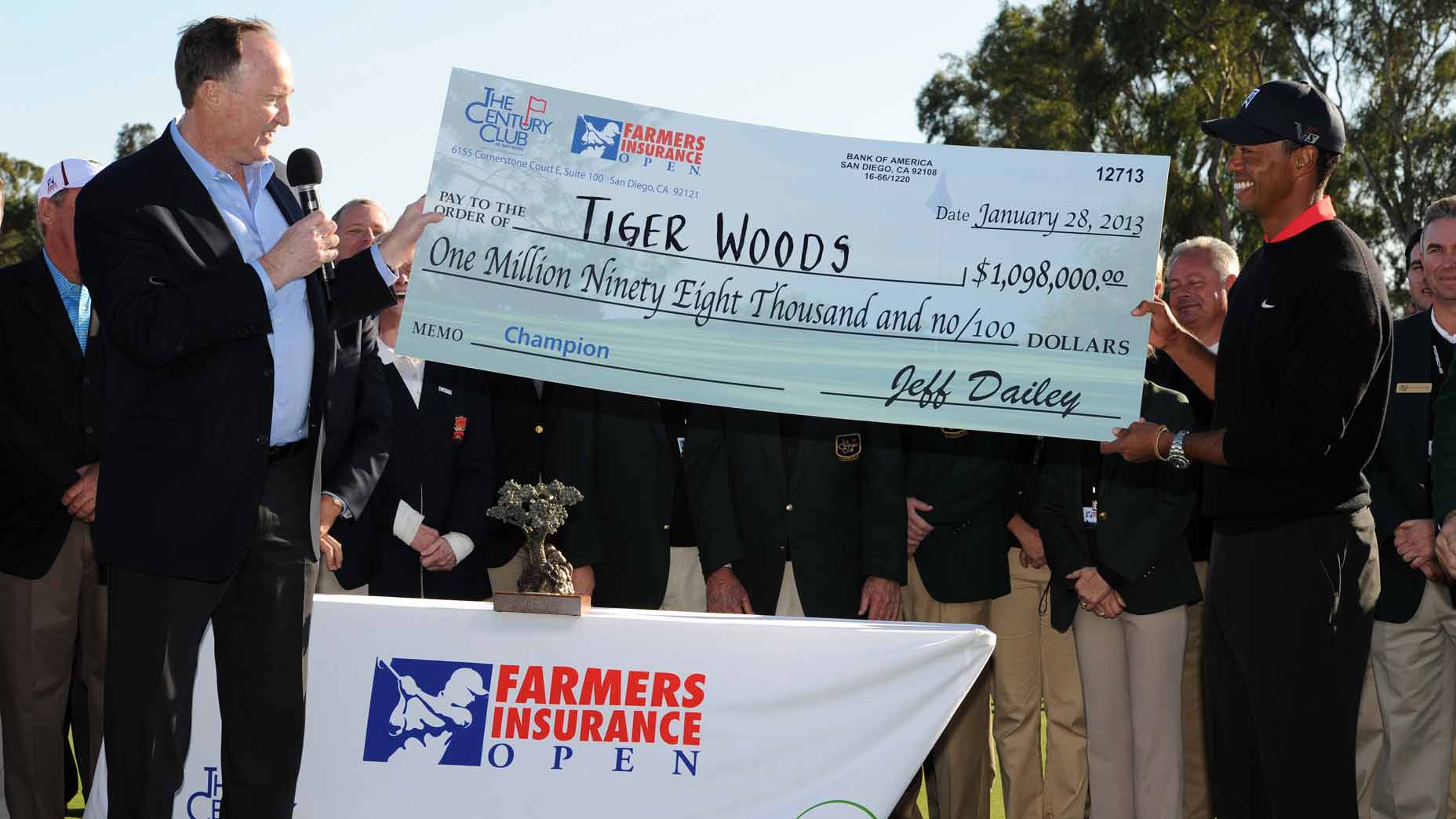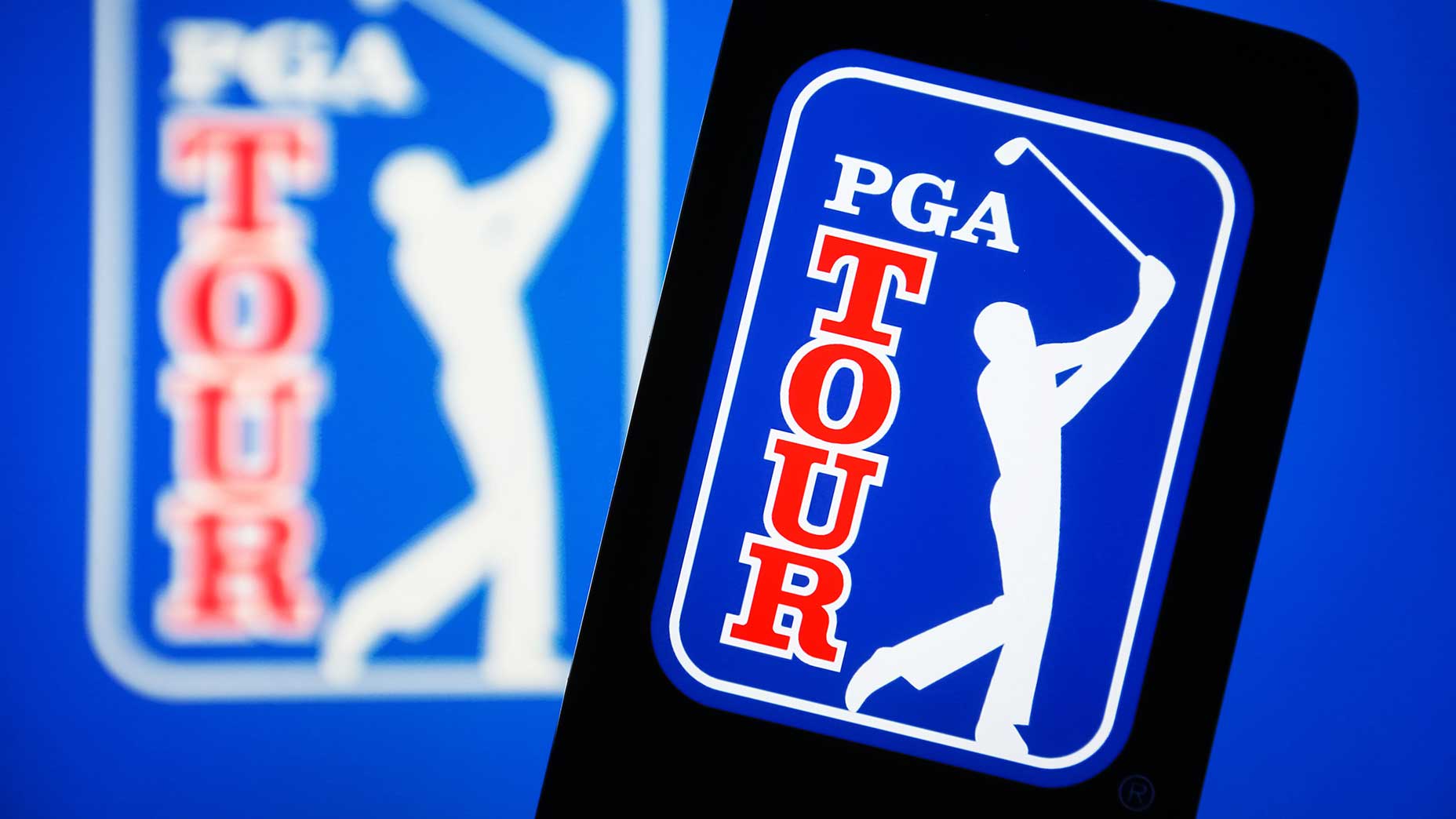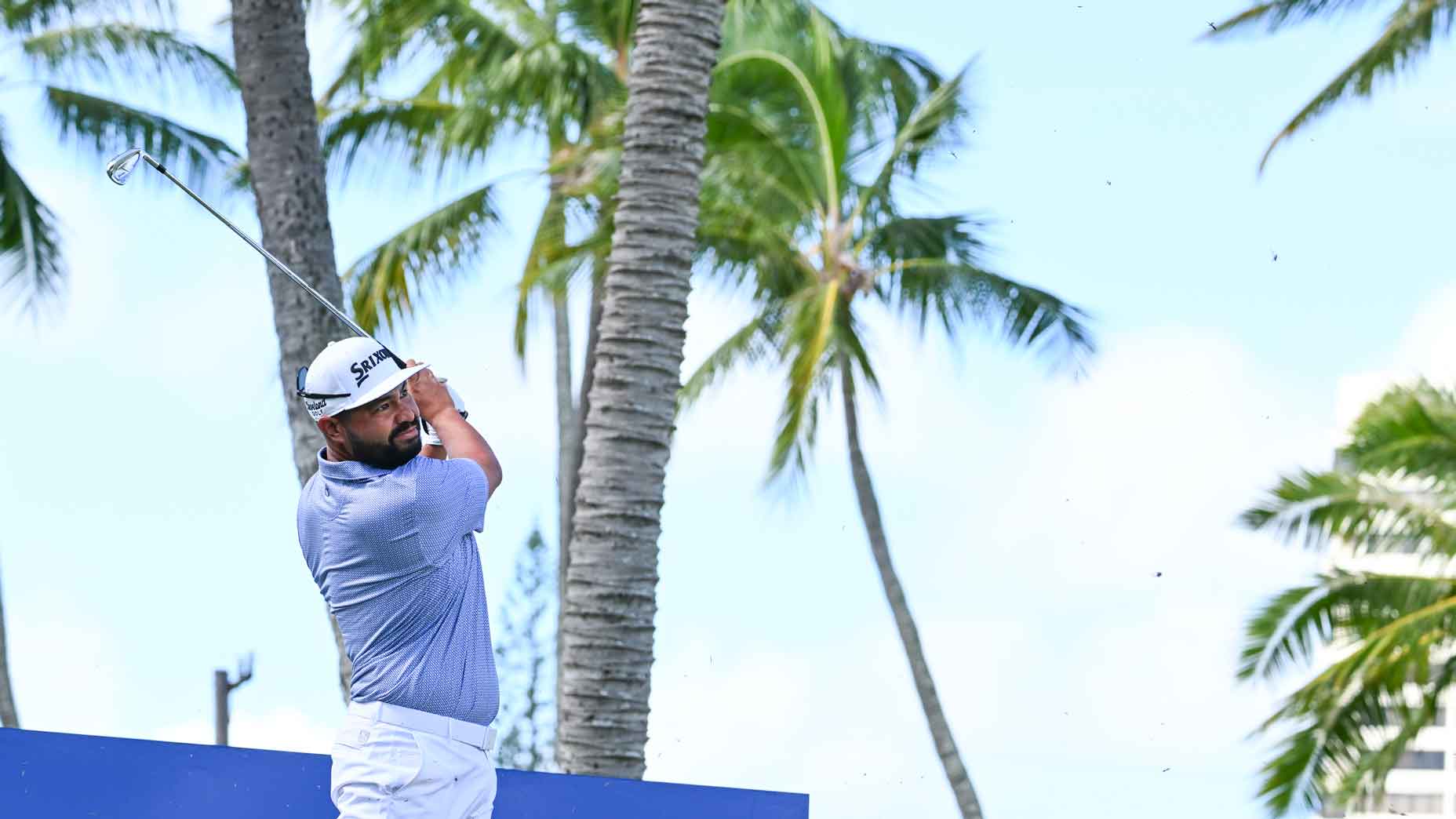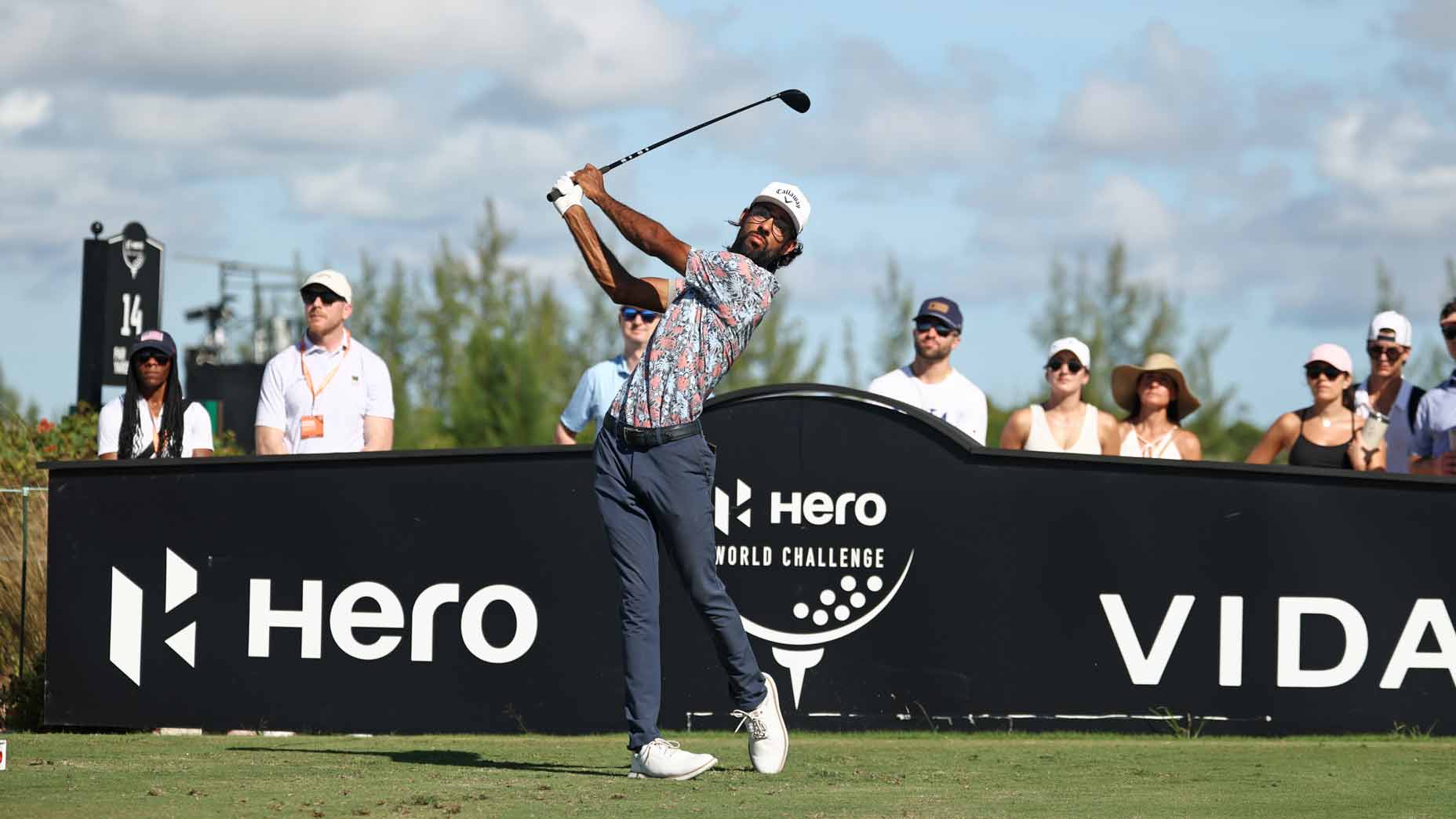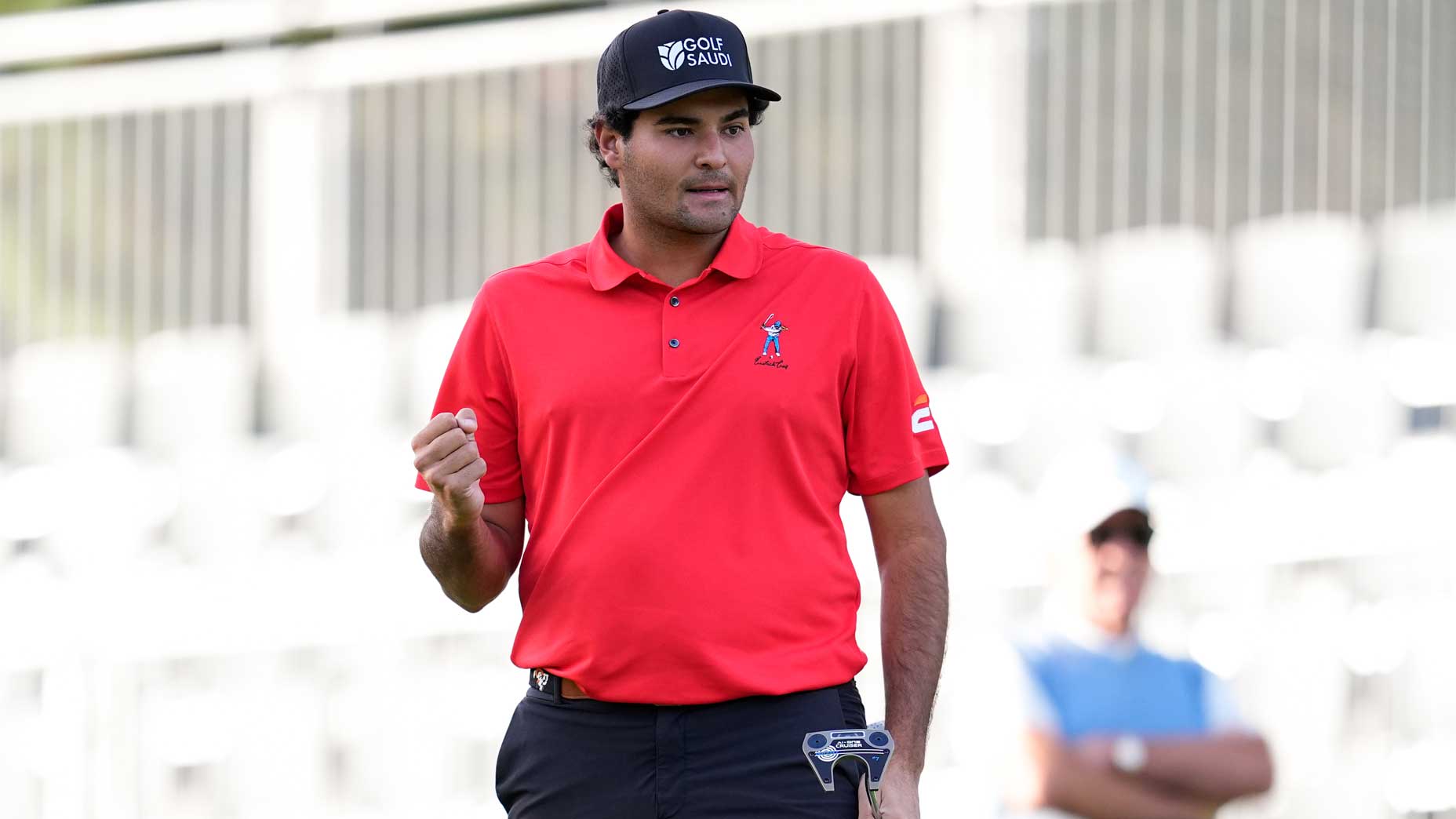BLAINE, Minn. — It’s 1:15 p.m. on a Thursday, and the first round of the 3M Open is underway on a hot, muggy and windy afternoon at TPC Twin Cities.
The 8th and 9th holes run parallel to each other, and behind the 8th tee, about 150 yards from the 9th green, Ken Tackett sits in a golf cart and waits. And waits. And waits some more. After a busy morning — about 25 total rulings across the course — his radio has suddenly gone quiet. He adjusts the volume and takes another look at the pace-of-play chart fastened to the steering wheel of his cart.
“I knew this would happen,” he says. “You’d come out and the radio would go silent.”
Tackett, 49, the lead rules official for the week, has a reporter shadowing him for the day, with the goal of attaining a behind-the-scenes look at how rulings, a critical component of professional golf, come together. Naturally, after said reporter shows up, the action slows.
This, rules officials will tell you, can be the boring part of the job. But for them, boring is good for business. Sometimes on slow days like this they’ll break up the dead radio air with subtle jabs at each other, needling Tampa sports or maybe Tar Heels basketball. Whatever helps kill time.
This moment reminds Tackett of an old rules official adage.
“Hours of boredom,” he says, “and moments of terror.”
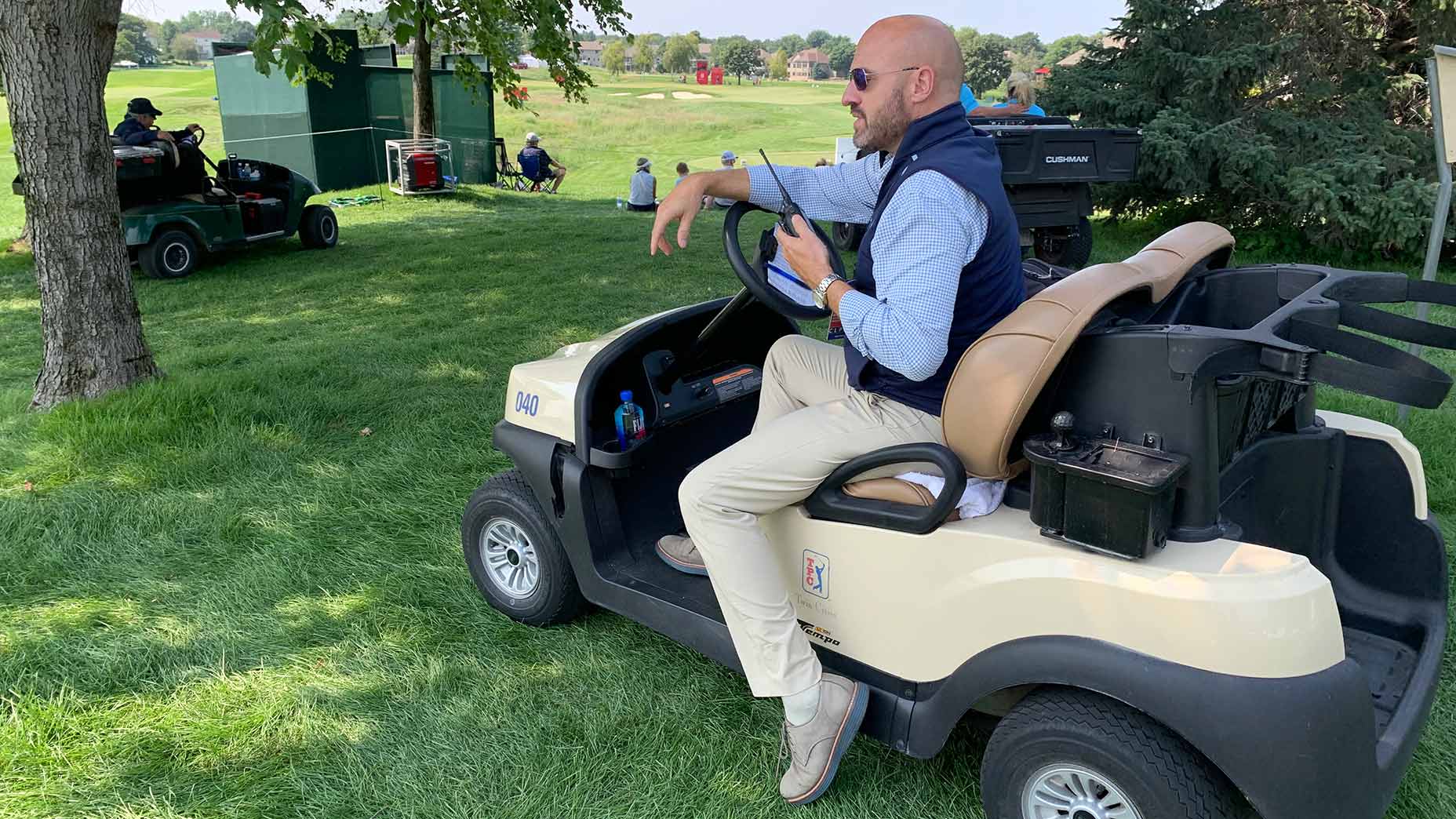
The term terror might be a bit of an exaggeration, but rulings happen with little warning, and officials need to be alert, timely, nimble, confident and sharp. They are golf’s firefighters — but instead of saving lives they save scorecards.
There’s a highly sophisticated system in place at every PGA Tour stop, which most fans hardly notice: 104 strategically placed ShotLink cameras, each one tracking shots and recording video footage, which rules officials can review.
There are about 18 members of the PGA Tour Rules Committee. At the 3M, like most tournaments, there are nine rules officials stationed around TPC Twin Cities, but that number balloons to 12 for bigger properties like TPC Sawgrass or TPC Scottsdale.
Of the nine officials here this week, eight are on the course, including the chief referee, who is Tackett this week. The other member of the team is Mark Dusbabek, the video rules analyst in the truck. Two of these officials set up the course every morning and one serves as the advance rules official, whose job is to work with tournament organizers year-round in the lead-up to the event. There also are two tournament administrators and a PGA Tour agronomist and meteorologist on-site with whom the rules officials frequently work.
Monday is usually a travel day. On Tuesdays, rules officials meet with local tournament staff to discuss course setup and other important logistics using shot and wind data, historical statistics and incoming weather. Obstacles, such as a windy weekend forecast, might influence how fast Tour officials make the greens on Thursday and Friday, because they typically like to increase green speeds as tournaments progress. Wednesday is pro-am day, by which point officials typically know where the pins will be set for most of the week, although there’s wiggle room.
“We don’t like to make decisions for Sunday on Wednesday,” Tackett says.
Come Thursday morning, everyone is in position. Tackett jokes it might often look as if rules officials are bored and staring at their devices, but they’re most likely analyzing the uber-important ShotLink app. They use it to track groups and make sure everyone is keeping up. (Pace-of-play monitoring accounts for most of their workload Thursday to Sunday.) The referees also have an app where they log all the rules situations they’re involved in, which is an important reference for future events. Several rulings near a concession stand on 14? Maybe next year they move the stand back another 10 feet. Confusion over a sandy area on 17? Be ready to remind players next season.
The 3M Open yielded nearly 100 documented rulings from Thursday to Sunday. When a rules clarification is needed, the walking scorer in the group radios the rules committee. Based on where officials are positioned, the dispatcher knows who is closest to respond. The on-the-spot officials might also radio those watching via video replay for a second opinion.
“We use reasonable judgement to make decisions often, but it’s a hell of a resource for us to have on the PGA Tour,” Tackett says about video replay. “I think we are just scratching the surface of using the resource. It’s just a matter of having the proper people in place. It’s just the next continued advancement of the game.”
A couple of decades ago, before he was a PGA Tour rules official, Tackett played music professionally and was a drummer at the Bellagio in Las Vegas. But after 9/11 he and his wife decided to move across the country and start their family in Charleston, W. Va. He kept his drumming sharp by playing in nearby cities — he loves R&B and jazz — but eventually was offered a part-time tournament director job with the West Virginia Golf Association. He climbed the ladder to executive director and, after 11 years, joined the Tour. This is his 11th season; he’s on the road about 200 days a year. He keeps a list on the Notes app of his phone with his favorite restaurants in each city. (New Orleans has the longest list.)
Tackett was involved in the infamous “fire ants” ruling with Bryson DeChambeau in 2020 and another fence-post ruling with DeChambeau that same year at the Memorial. Most rulings, though, aren’t televised.
“Often they are looking for clarity, kind of like confirmation,” Tackett says. “It’s a two-stroke penalty playing from the wrong place, and we are literally one-minute away to help.”
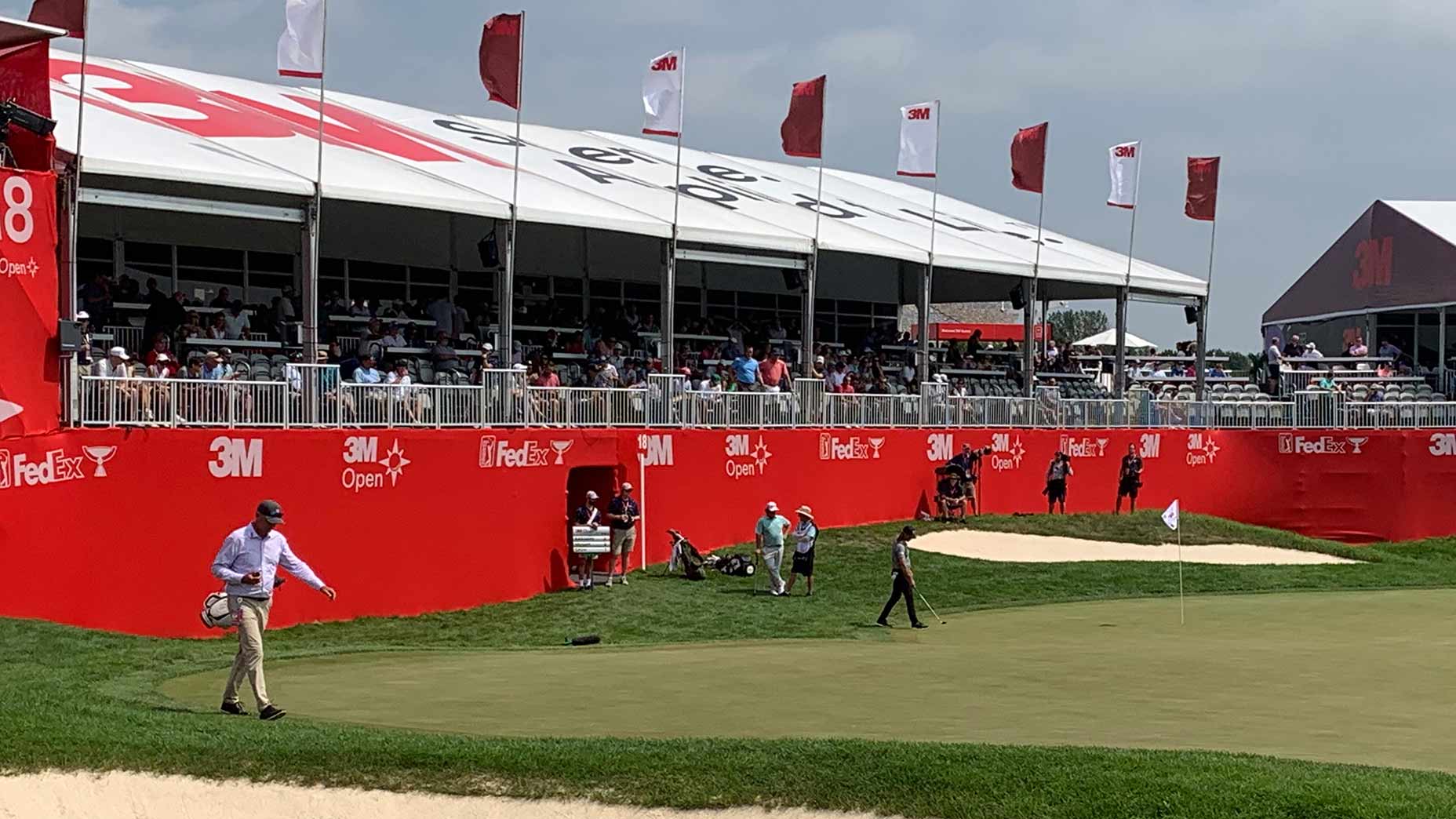
IT’S 11:20 A.M. ON FRIDAY, and Jason Larson has been busy. Kevin Kisner and Emiliano Grillo both needed video review to determine if their balls crossed the hazard line in front of a green. J.T. Poston had a question about a drop. David Skinns wanted to know if he could brush sand off the green. Bill Haas needed relief with his ball abutting a hospitality tent.
Larson is stationed just left of the 18th fairway at TPC Twin Cities, which isn’t a bad hangout for fans with its abundance of shade, wood-fired pizzas, cocktails and craft beer. But for a rules official, it makes for a hectic day at the office.
The par-5 closer wraps around a lake with water in play on every shot and ranks high in lost-ball numbers on Tour. Several rulings are clarifications regarding balls crossing (or not crossing) the hazard line before splashing. Others are about balls up against the hospitality tents or grandstands that line the hole.
“This hole can be a mess,” Larson says.
As the advance rules official for the 3M Open, Larson came in a week early to make sure things such as signage and scoreboards were put in the correct spots and that everything else was falling into place. He also marked the entire course — that paint you see around water and out-of-bounds areas — which took about 2 1/2 days. Larson, 55, was a college golfer at LSU before he played professionally for a few years. He joined the ShotLink operations staff in 2007 and 11 years later became a rules official on the PGA Tour Champions, then the Korn Ferry Tour. He joined the PGA Tour in 2022 and, like Tackett, is away from home about 200 days a year.
His phone rings; it’s Tackett, about a group that’s falling behind pace.
“How far are they behind?” Larson asks. He looks at his pace-of-play sheet and explains the factors that go into it. In short, if players are in position with the group in front of them, they are good. But on a par-5, for example, a group must get three shots in before the group in front finishes the hole to be considered in position. On par-4s, at least one player in a group must have teed off before the group ahead puts the flag in.
These back-ups usually take care of themselves with players getting back into position after they are slowed down by rulings, bad holes or backups, but if they don’t get back on track they receive an official pace warning.
“A lot of people think we are out here cracking down on the rules to penalize guys,” Larson says. “That’s the furthest thing from the truth. My thought process is, what I can I do to help this player get out of this situation, within the rules. Our ultimate goal is to be bored. If we are bored, if we have nothing to do, that’s a good thing.”
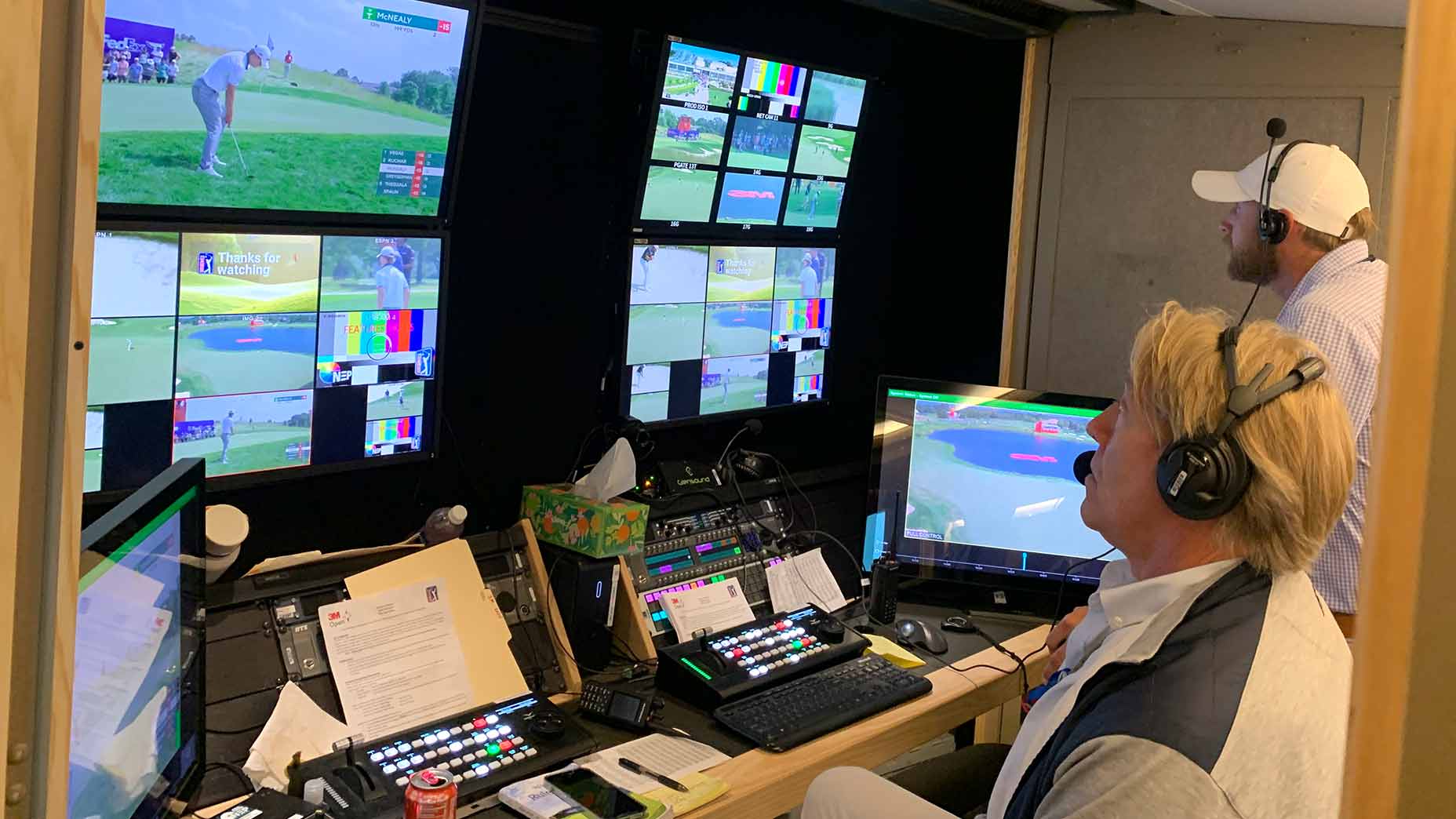
IT’S 3:25 P.M. ON SUNDAY, and the final group of Maverick McNealy, Jhonattan Vegas and Matt Kuchar have reached their tee balls in the 14th fairway. The gallery starts to swell as drones buzz overhead. All three players are at 15 under and in a four-way tie (along with rookie Max Greyserman) for the 3M Open lead. One is likely to win. (And one did.) Crunch time, and the same can be said for the inhabitants of a truck 100 yards to their right.
The TV compound beyond the 14th is packed with trucks and trailers populated by important people making all the action come to life. Mark Dusbabek sits in the truck closest to the course, a space barely big enough to hold the former NFL linebacker.
The 8-by-5 room is stocked with monitors and screens and dashboards and buttons and keyboards. Radios sit on the desk. A weathered paperback copy of the Rules of Golf is within reach.
This is Dusbabek’s office for 21 tournaments a season. Jordan Harris sits to his right and monitors seven different screens via the Hawkeye system. He can switch feeds, rewind them, enhance and search for rulings on certain holes. He also has an eye on the CBS cameras, so he’s able to give rules officials a quick heads up that a ruling might be coming.
Dusbabek focuses mostly on the main broadcast. He wears a headset with the broadcast in one ear and a CBS producer in the other. Dusbabek and Harris are both proactively watching the action, but they are not trying to make rulings. Their job is to put officials in position — and even help inform them — so they are prepared and able to solve rules issues in a timely manner.
“We are helping the players more than we are hurting them,” Dusbabek says. “Rarely are we giving penalties — we are more keeping them from getting penalties.”
The broadcast also needs to end at a certain time, and handling these rulings, some more complex than others, is crucial to keeping the tournament moving along. Dusbabek also supplies on-course reporters with nuggets they can relay on the broadcast. He just fired off a text to CBS’s Ian Baker-Finch and Frank Nobilo, informing them about what the agronomy team did to the greens in the morning.
“There’s so much behind the scenes that we are doing that nobody knows about,” Dusbabek says. “CBS is doing its production, its show. We are only there to help and assist with anything that might come up.”
Dusbabek, 60, had an unlikely path to his post. He lives in San Diego, but he was born 80 miles south of here in Faribault, Minn. He was a star player for the high school football team and, at 6-foot-3, 230 pounds, played linebacker for the Minnesota Gophers. The Houston Oilers drafted him in the fourth round of the 1987 NFL Draft; he ended up playing three seasons with the Minnesota Vikings before retiring.
Dusbabek was in finance for five years before he decided to get into golf. He volunteered in Southern California for a year and later was hired by the local PGA Section. He eventually went back to Southern California and worked there for five more years before he joined the PGA Tour as a rules official. Three years ago, he transitioned from the course to the trailer, where he now spends virtually all of his time. This is his 19th year with the Tour.
A major project Dusbabek is working on now is helping prep the Tour’s Ponte Vedra Beach, Fla., headquarters with a state-of-the-art video replay center the Tour plans to launch in 2025 (with a test run coming at the RSM Classic in November). The dazzling new space will support more technology, more monitors — more everything — and will allow the Tour to expand video review not only for the PGA Tour but also for the Korn Ferry Tour and perhaps even the PGA Tour Champions. Currently, the Tour has video review for about only half of its events, but next year, with the new HQ, about 95 percent of tournaments will have video review. Dusbabek, from his spot on-site, will communicate directly with Ponte Vedra.
“I feel like we are so far behind compared to other sports, so we are trying to catch up,” Dusbabek says. “We do incremental steps every year so it’s going to get bigger and better, and next year will be a huge improvement for us.”
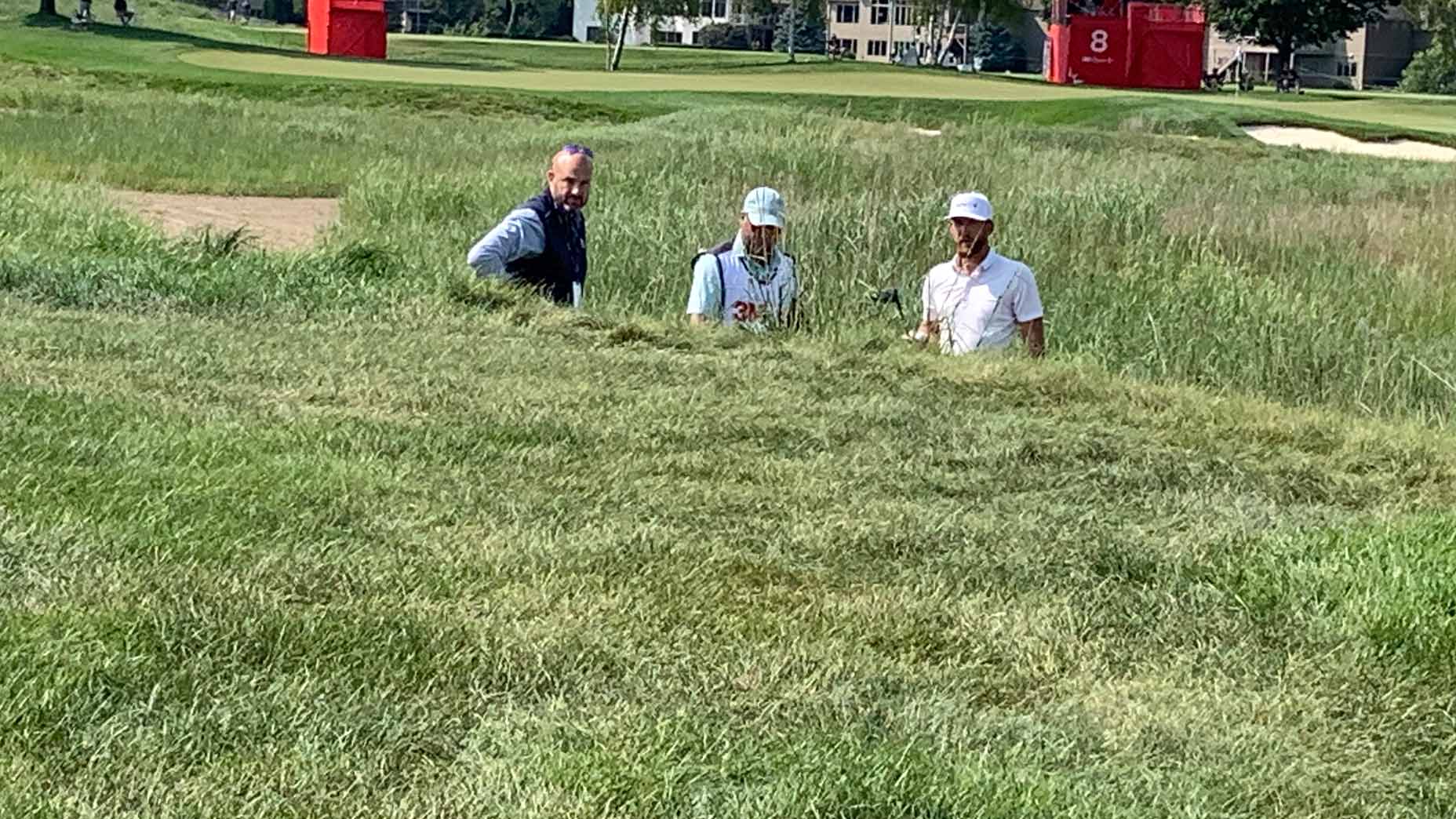
IT’S 4:11 P.M. ON THURSDAY, and Tackett’s still posted up behind the 8th tee. There were a handful of rules situations around the lunch hour — Kevin Yu on 18, another ruling on 16, a Sam Burns penalty on 7 — but none in his area (still!) since the fly-on-the-wall reporter returned 90 minutes ago.
But in this job, things can and do change quickly. Tackett’s radio crackles. An official is needed in the 9th fairway.
“That’s us,” he says.
This is it. We hop in the cart and cruise down a hill, lifting the rope over our heads before we rumble up the near side of the 9th fairway. In the distance, Kevin Chappell puts his hand up. The moment triggers a surprising adrenaline rush — but maybe that’s just for the passenger, giddy to finally get some action and somewhat curious to know if this is caught on TV (it wasn’t).
Tackett hops out of the cart and shuffles down a side hill to where the knee-high native area separates the first cut from a natural sandy area. Chappell’s ball embedded in the bank, and he’s inquiring about relief options. The sandy terrain behind Chappell — which he originally thought was a bunker — is, in fact, part of the general area. When taking embedded ball relief, dropping in a bunker is not permitted.
There also was an animal hole beside where the ball was embedded, from which Chappell thought he got two club-lengths relief. But that’s not the case (it’s one club-length). Plus, Tackett said the animal hole did not hinder Chappell’s stance or the area of his intended swing, so no relief was granted.
“Where the ball was embedded, if he planned to play it and not take relief from the embedded ball, he wouldn’t have interference from the animal hole anyway,” Tackett says. “He wouldn’t get relief unless you take relief from the embedded ball, drop it in the animal hole, then took relief from the animal hole, but he still wouldn’t get to the same spot [he wanted to].”
Chappell was hopeful he could drop farther away from the bank to clear the lip, but he was left with a tricky angle from 223 yards out. He dropped in the sandy area and readied to hit his shot. Tackett returned to the cart and drove away.
That’s when Bill Haas waved him over. Haas, who was in the group, wanted to clear up a ruling with Tackett from a few weeks earlier. It was a nice gesture from the pro and mutual sign of respect. Haas told Tackett to take it easy on them with the Friday tee markers. They both laughed. Tackett drove on but didn’t get far. There was Chappell again. The ball he had hit from the sandy area had come to rest between the lip of the grass and the cart path about 100 yards from the green.
“Can’t make this s— up, man,” Chappell said, grinning. After hours without action, two rulings with the same player came on back-to-back shots. This litigation didn’t take as long. After Tackett helped Chappell take nearest point of relief from the immovable obstruction, Chappell dropped, wedged on and two-putted.
Tackett jumped back into the cart, drove 20 yards and parked in his spot behind the 8th tee, escaping the broiling sun. In four minutes, he had cleared up two rules situations — one of which had multiple layers — and talked to another pro about a previous incident.
“What’d I tell you?” Tackett says, smiling. “Hours of boredom. Moments of terror.”



